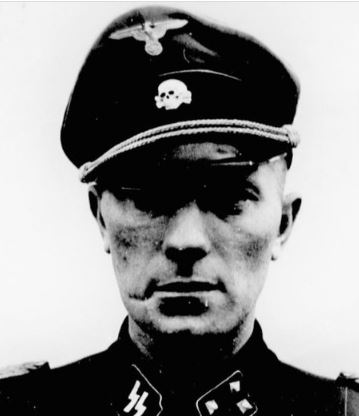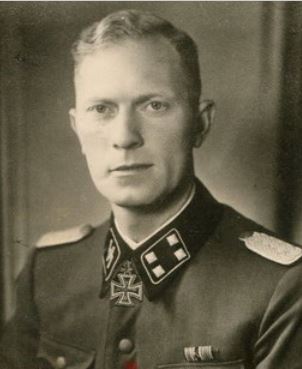Tappe, Martin (SS-Polizei-Pz-Gren.Reg.8)
- Date of birth:
- January 10th, 1910 (Löhne/Westphalia, Germany)
- Date of death:
- April 19th, 1969 (Wuppertal-Barmen/Northrhine-Westphalia, Germany)
- Service number:
- SS Nr.: 279.457 // NSDAP-Nr.: 2.731.434
- Nationality:
- German (1933-1945, Third Reich)
Biography
Promotions:
01.05.1933 -- SA-Mann
13.10.1935 -- SS-Rottenführer
30.01.1936 -- SS-Unterscharführer
01.10.1936 -- SS-Scharführer
16.02.1937 -- SS-Hauptscharführer
20.04.1937 -- SS-Untersturmführer
20.04.1937 -- Leutnant der Schutzpolizei
01.10.1937 -- Gefreiter d. R.
09.11.1938 -- SS-Obersturmführer
09.11.1938 -- Oberleutnant der Schutzpolizei
30.01.1940 -- SS-Hauptsturmführer
00.00.1940 (?) -- Hauptmann der Schutzpolizei
09.11.1943 -- SS-Sturmbannführer
00.00.1943 (?) -- Major der Schutzpolizei
00.00.1945 (?) -- SS-Obersturmbannführer (? Per Veit Scherzer, E. G. Krätschmer, and Jost Schneider, this was his final rank; Mark C. Yerger states he ended the was as an SS-Sturmbannführer)
00.00.1945 (?) -- Oberstleutnant der Schutzpolizei (?)
Career:
01.05.1933: entered the NSDAP
13.10.1935: entered the SS
20.04.1937-01.05.1937: SS-Führer-Schule Braunschweig
00.03.1945: SS-Sturmbannführer und Major der Schutzpolizei, Kdr., II.Bataillon, SS-Polizei-Panzergrenadier-Regiment 8, 4. SS-Polizei-Panzergrenadier-Division
Do you have more information about this person? Inform us!
- Period:
- Second World War (1939-1945)
- Awarded on:
- July 29th, 1940
- Period:
- Second World War (1939-1945)
- Awarded on:
- August 20th, 1941
- Period:
- Second World War (1939-1945)
- Awarded on:
- September 30th, 1941
- Period:
- Second World War (1939-1945)
- Awarded on:
- October 3rd, 1941
- Period:
- Second World War (1939-1945)
- Awarded on:
- November 1st, 1941
- Period:
- Second World War (1939-1945)
- Awarded on:
- August 14th, 1942
- Period:
- Second World War (1939-1945)
- Period:
- Second World War (1939-1945)
- Rank:
- SS-Sturmbannführer (Major)
- Unit:
- Kdr, SS-Panzergrenadier-Regiment 8, 4. SS-Polizei-Division
- Awarded on:
- March 24th, 1945
- Period:
- Second World War (1939-1945)
- Rank:
- SS-Obersturmbannführer (Lieutenant-colonel)
- Unit:
- Kommandeur, II. Bataillon, SS-Polizei-Panzergrenadier-Regiment 8, 4. SS-Polizei-Panzergrenadier-Division, VII. Panzer-Korps, Armeeoberkommando 2, Heeresgruppe Nord
- Awarded on:
- March 28th, 1945
“The 4. SS-Pol.Pz.Gren.Div. had the mission of launching a surprise advance from the Theiß bridgehead at Szolnok, a move which was aimed at Oden (near Debrecen) in order to bring relief to the hard fighting friendly divisions there. In prosecuting this aim it captured the village of Kenderes on the 13.10.1944 after passing through Török-Szt.Miklos and Szaparfalu. However the continued advance towards Kisujszallas bogged down under heavy enemy artillery, anti-tank and mortar fire. After being forced to evacuate Kenderes that night due to a strong enemy counterattack, and then establishing a security line along the western edge of the village, the divisional commander decided on a renewed attempt to take Kisujszallas from the southwest with a wide flanking maneuver south of the railway line.
Division’s Orders: After assembling south of the railway line, two battalions of the SS-Pol.Pz.Gr.Rgt. 8 (II. Bataillon on the right, III. Bataillon on the left with its left wing adjacent to the railway) were to punch through the strong enemy blocking positions south of the railway. They would then capture Kisujzallas and open up the Kenderes—Kisujszallas road from the rear. The Regiment’s I. Bataillon and the II./SS-Pol.Pz.Gr.Rgt. 7 would at the same time capture Kenderes.
The II./SS-Pol.Pz.Gr.Rgt. 8 reached the assembly area without enemy contact. On the other hand the III./SS-Pol.Pz.Gr.Rgt. 8 came under strong enemy attack while on the march north of the railroad, taking losses and becoming tied down in the process.
The commander of the II./SS-Pol.Pz.Gr.Rgt. 8, SS-Sturmbannführer Tappe, had no communications available with either the Regiment or the Division. Even with the gravity of the situation, he nonetheless decided to go ahead with the attack on his own. Despite the significant flank threat from the enemy positions along the railway embankment to the north, the Bataillon managed to break through the heavily occupied enemy positions west of Kisujszallas with SS-Sturmbannführer Tappe at its head. Disregarding all enemy flank attacks, it penetrated through to Kisujszallas and captured the village in the face of fierce resistance from the enemy garrison (which was far superior in men and materiel). The enemy pulled back to the east in disorder and had to leave behind substantial quantities of materiel. In the subsequent defensive battles, Kisujszallas was held by SS-Sturmbannführer Tappe against the immediately launched enemy counterthrusts.
Meanwhile all the Division’s attempted attacks to recapture Kenderes, as well as the newly commenced advances of the III./SS-Pol.Pz.Gr.Rgt. 8 towards the east while north of the railroad, came to a standstill against heavy enemy fire.
Recognizing the major threat posed by the loss of Kisujszallas, over the course of the afternoon the enemy brought up additional strong motorized and armoured forces from Kunhegyes, Turkeve and Karczag. In spite of overwhelming enemy pressure, all attacks of these new troops were repulsed. Every penetration was cleaned up through numerous counterthrusts.
In the morning hours of the 15.10.1944 the I./SS-Pol.Pz.Gr.Rgt. 8, ordered by the Division to relieve Kampfgruppe Tappe, was halted by strong enemy resistance just south of the railway line near Wenkheim. A further relief attempt with an armoured group also failed. The reinforced enemy was at the same time launching continual attacks (especially from the east) against the positions of the II./SS-Pol.Pz.Gr.Rgt. 8 along the village edge. SS-Sturmbannführer Tappe directed the defense with inexorable calm and denied the enemy their entry into the village.
At 16:30 the IV. Panzer-Korps issued the order to evacuate Kisujszallas. An enemy thrust from the south against Török-Szt.Miklos had placed the supply road of the Division under threat, and thus its units needed to pull back to the west.
Deploying all his forces along a narrow front, SS-Sturmbannführer Tappe managed to break through the encirclement ring around Kisujzallas in a bold attack. With only slight casualties, his group made contact with the bulk of the Division in the area west of Kenderes. During this movement the Bataillon had managed to bring all of its dead and wounded along with it.
It has been confirmed by reports and prisoner statements that the surprise thrust and subsequent brave stand of Tappe’s Bataillon had major implications for the fighting in the area. These actions diverted strong enemy motorized and tank forces (belonging to the 6th Guards Tank Army) from the area east of Karczag, which in turn brought noticeable relief to the hard pressed German divisions fighting there.
As a result of his swift decision to advance onto Kisujszallas despite having no support from friendly forces, and his subsequent determined defense of the village, SS-Sturmbannführer Tappe had a major share in fulfilling the Division’s task of drawing strong enemy forces to it. In all phases of this battle, in which he always stood in the foremost line as a shining example to his Bataillon, SS-Sturmbannführer Tappe showed that he is worthy of the award of the Knight’s Cross to the Iron Cross.”
based on a recommendation dated 10.02.1945 and signed by Div. Kdr. Walter Harzer
Sources
- Photo 1:
- Photo 2:
- - FELLGIEBEL, W.P., Elite of theThird Reich, Helion & Company Limited, Solihull, 2003.
- PATZWALL, K. & SCHERZER, V., Das Deutsche Kreuz 1941-1945, Verlag Klaus D. Patzwall, Norderstedt, 2001.
- Microfilm Publication A3343. US National Archives.


















